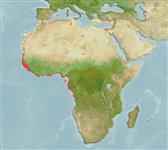>
Beloniformes (Needle fishes) >
Hemiramphidae (Halfbeaks)
Etymology: Hyporhamphus: Greek, hypo = under + Greek, rhamphos = beak, bill (Ref. 45335).
Eponymy: Monsieur Picart is said to have contributed natural history specimens from Cádiz, Spain, to the ‘King’s Cabinet’, but no further elaboration is made. (Ref. 128868), visit book page.
More on author: Valenciennes.
Environment: milieu / climate zone / depth range / distribution range
Écologie
marin; saumâtre benthopélagique; profondeur 0 - ? m. Subtropical; 37°N - 9°S, 18°W - 36°E
Eastern Atlantic: West to Gibraltar, Morocco and Dakar, Senegal to Luanda, Angola. Eastern Mediterranean: From Lebanon and Israel.
Taille / Poids / Âge
Maturity: Lm ? range ? - ? cm
Max length : 20.0 cm TL mâle / non sexé; (Ref. 26999); common length : 15.0 cm TL mâle / non sexé; (Ref. 26999)
Description synthétique
Clés d'identification | Morphologie | Morphométrie
Épines dorsales (Total) : 0; Rayons mous dorsaux (Total) : 13 - 16; Épines anales: 0; Rayons mous anaux: 13 - 17. Diagnosis: body elongate; lower jaw forming long, narrow beak; upper jaw short, triangular and scaled; scales on snout; well developed preorbital crest between eye and nasal pit; pelvics fin abdominal; dorsal and anal fins placed far back on body and spineless; caudal fin slightly forked (Ref. 57227).
Occurs in coastal waters. Often enters estuaries (Ref. 2683). Live on or near the bottom where it feeds on algae and organic debris which it gathers from the surface of the sediment (Ref. 5377). Forms schools. Attracted to lights at night. Eggs are attached to aquatic vegetation by sticky threads (Ref. 6730).
Life cycle and mating behavior
Maturité | Reproduction | Frai | Œufs | Fécondité | Larves
Collette, B.B. and N.V. Parin, 1990. Hemiramphidae. p. 579-582. In J.C. Quero, J.C. Hureau, C. Karrer, A. Post and L. Saldanha (eds.) Check-list of the fishes of the eastern tropical Atlantic (CLOFETA). JNICT, Lisbon; SEI, Paris; and UNESCO, Paris. Vol. 2. (Ref. 4497)
Statut dans la liste rouge de l'IUCN (Ref. 130435: Version 2024-1)
Menace pour l'homme
Harmless
Utilisations par l'homme
Pêcheries: commercial
Outils
Articles particuliers
Télécharger en XML
Sources Internet
Estimates based on models
Preferred temperature (Ref.
123201): 18.4 - 27.9, mean 21.9 °C (based on 146 cells).
Phylogenetic diversity index (Ref.
82804): PD
50 = 0.5000 [Uniqueness, from 0.5 = low to 2.0 = high].
Bayesian length-weight: a=0.00257 (0.00115 - 0.00574), b=3.09 (2.91 - 3.27), in cm total length, based on LWR estimates for this Genus-body shape (Ref.
93245).
Niveau trophique (Ref.
69278): 2.0 ±0.00 se; based on food items.
Résilience (Ref.
120179): Haut, temps minimum de doublement de population inférieur à 15 mois (Preliminary K or Fecundity.).
Fishing Vulnerability (Ref.
59153): Low vulnerability (10 of 100).
